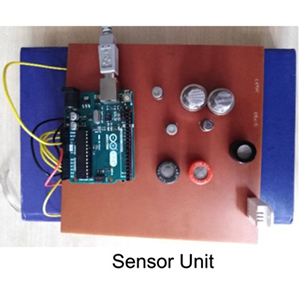E-nose: a low-cost fruit ripeness monitoring system

Published: 3 November 2022
Abstract Views: 2706
PDF: 938
HTML: 618
HTML: 618
Publisher's note
All claims expressed in this article are solely those of the authors and do not necessarily represent those of their affiliated organizations, or those of the publisher, the editors and the reviewers. Any product that may be evaluated in this article or claim that may be made by its manufacturer is not guaranteed or endorsed by the publisher.
All claims expressed in this article are solely those of the authors and do not necessarily represent those of their affiliated organizations, or those of the publisher, the editors and the reviewers. Any product that may be evaluated in this article or claim that may be made by its manufacturer is not guaranteed or endorsed by the publisher.
Similar Articles
- Ziyan Fan, Lijun Li, Zicheng Gao, Fuzzy neural network PID control design of camellia fruit vibration picking manipulator , Journal of Agricultural Engineering: Vol. 54 No. 2 (2023)
- Andrea Peruzzi, Luisa Martelloni, Christian Frasconi, Marco Fontanelli, Michel Pirchio, Michele Raffaelli, Machines for non-chemical intra-row weed control in narrow and wide-row crops: a review , Journal of Agricultural Engineering: Vol. 48 No. 2 (2017)
- Yerong Sun, Kechuan Yi, Agricultural machinery photoelectric automatic navigation control system based on back propagation neural network , Journal of Agricultural Engineering: Vol. 54 No. 4 (2023)
- Giuliano Vox, Pierfrancesco Losito, Fabio Valente, Rinaldo Consoletti, Giacomo Scarascia-Mugnozza, Evelia Schettini, Cristoforo Marzocca, Francesco Corsi, A wireless telecommunications network for real-time monitoring of greenhouse microclimate , Journal of Agricultural Engineering: Vol. 45 No. 2 (2014)
- Xiong Bi, Hongchun Wang, Double-branch deep convolutional neural network-based rice leaf diseases recognition and classification , Journal of Agricultural Engineering: Vol. 55 No. 1 (2024)
- Wei Deng, Chunjiang Zhao, Liping Chen, Xiu Wang, Constant pressure control for variable-rate spray using closed-loop proportion integration differentiation regulation , Journal of Agricultural Engineering: Vol. 47 No. 3 (2016)
- Raffaele Cavalli, Stefano Grigolato, Marco Pellegrini, The evolution of a mountain road network from its original use during the First World War to meeting today’s forestry needs: current management , Journal of Agricultural Engineering: Vol. 43 No. 3 (2012)
- Emanuel Rigon, Johnny Moretto, Riccardo Rainato, Mario Aristide Lenzi, Andrea Zorzi, Evaluation of the morphological quality index in the Cordevole river (Bl, Italy) , Journal of Agricultural Engineering: Vol. 44 No. 3 (2013)
- İlker Ünal, Önder Kabaş, Salih Sözer, Comparison of two different artificial neural network models for prediction of soil penetration resistance , Journal of Agricultural Engineering: Vol. 55 No. 1 (2024)
- Yun Zhu, Shuwen Liu, Xiaojun Wu, Lianfeng Gao, Youyun Xu, Multi-class segmentation of navel orange surface defects based on improved DeepLabv3+ , Journal of Agricultural Engineering: Vol. 55 No. 2 (2024)
You may also start an advanced similarity search for this article.

 https://doi.org/10.4081/jae.2022.1389
https://doi.org/10.4081/jae.2022.1389 






